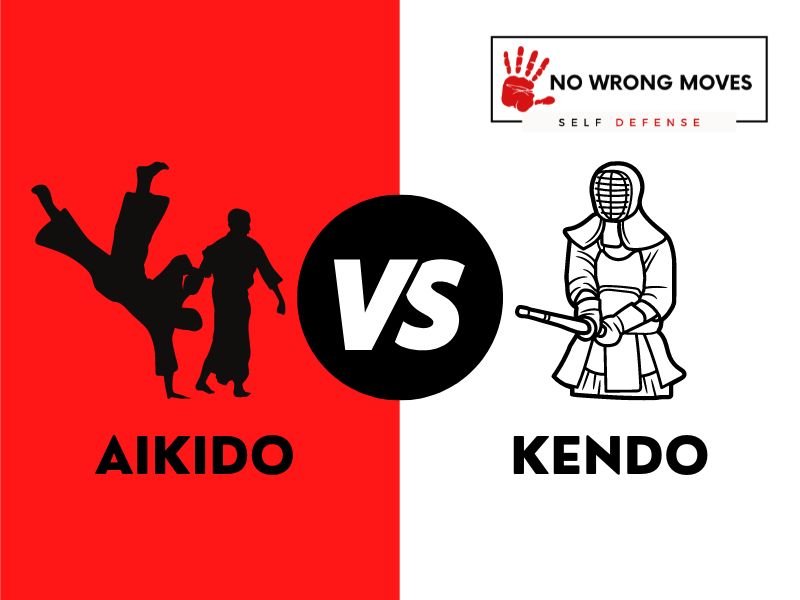
- What We Know About Aikido
- What We Know About Kendo
- Key Elements Of Aikido
- Key Elements Of Kendo
- Aikido Rankings & Levels
- Kendo Rankings & Levels
- Aikido Vs. Kendo Attire
- What A Typical Aikido Training Session Looks Like
- What A Typical Kendo Training Session Looks Like
- Aikido Movies
- Conclusion: Aikido Vs. Kendo
Many people in the martial arts community debate whether Aikido or Kendo is the better practice. While both offer unique benefits and principles, there are some key differences that set them apart.
The main difference between Aikido and Kendo is the focus of either martial art.
Kendo, translated as "the way of the sword," is a traditional Japanese martial art that focuses on sword-based combat and physical discipline.
Aikido, on the other hand, translated as "the way of harmony," is a modern Japanese martial art that emphasizes non-resistance and redirecting an attack's energy.
In Kendo, practitioners wear protective armor and use wooden swords to simulate real combat. There's typically no need for that in Aikido--no one really wears any protective gear, as its emphasis is on redirecting and controlling their movement without causing harm.
Kendo also has a strong emphasis on precise strikes in specific areas, while Aikido focuses on controlling the overall movement and flow of a situation.
Another key difference is that Kendo has established competition and ranking systems, while Aikido does not typically participate in organized competitions.
One area where they do overlap though is that both martial arts have similar philosophies regarding respect, discipline, and self-improvement. It's just that they each have different methods and focuses.
So the choice between practicing Kendo or Aikido comes down to personal preference and your overarching goals. Both offer physical discipline and mental focus, but with different approaches and focuses on combat techniques.
What We Know About Aikido

The art of Aikido is overall a defensive martial technique. This means it's not intended to work aggressively, but rather when somebody becomes aggressive towards you. The aggressor in this case will often take on some form or another.
A lot goes into each movement, regardless of if it's standing still or moving around. has been considered aesthetically beautiful thanks largely due to its fluidity and grace. Learning how to properly balance yourself and redirect an attacker’s energy is key for the art of Aikido.
One important aspect of Aikido is also being able to control your own emotions during a potentially tense situation. It teaches practitioners to remain calm and in control, instead of escalating conflicts or resorting to violence as a first option.
Overall, Aikido is not just about learning self-defense techniques, but also about the discipline and mindfulness that goes into each movement and decision made during an altercation. It can be a fulfilling practice for both the body and mind.
What We Know About Kendo

Kendo is a Japanese martial art that involves full-speed, full-contact fighting using split bamboo swords. The word Kendo quite literally means "way of the sword," and it is considered one of the most challenging and demanding martial arts.
As a consequence of the naturally potentially dangerous nature of the sport, Kendo practitioners wear light armour called bogu, which protects the head, torso, and wrists.
In order to practice kendo effectively, practitioners need a partner to help them perfect their techniques. That doesn't mean you can't practice on your own though--there are lots of solo drills that you can implement too, useful for honing your skills.
In addition to physical prowess, Kendo also cultivates mental strength and self-discipline. As a martial art, Kendo can be used for self-defense and competition, but it is also deeply rooted in traditional Japanese culture and philosophy.
And that's something I've definitely noticed while looking into this martial art. The ultimate goal of Kendo is not simply to win against an opponent, but rather to improve oneself and perfect one's character.
Kendo is also a highly social activity--what with you mashing swords at each other's faces and all--with many practitioners belonging to local or regional kendo clubs.
These clubs often organize events and tournaments for members to compete in, as well as providing a community for kendo practitioners to share their passion and support each other in their training.
All-in-all, Kendo can be a physically and mentally rewarding practice for those willing to commit themselves fully to its rigorous training.
Of course, this is only a brief history and understanding of Aikido and Kendo, but if you want to go deeper into either art, be sure to check out the following posts:
Now, back to the comparison...
Let's look at the origins of the respective disciplines and then compare the key elements of their practices. You will be able to understand some of their similarities and differences a bit better afterward.
| Aikido | Kendo | |
| Origins | Japanese | Japanese |
Key Elements Of Aikido
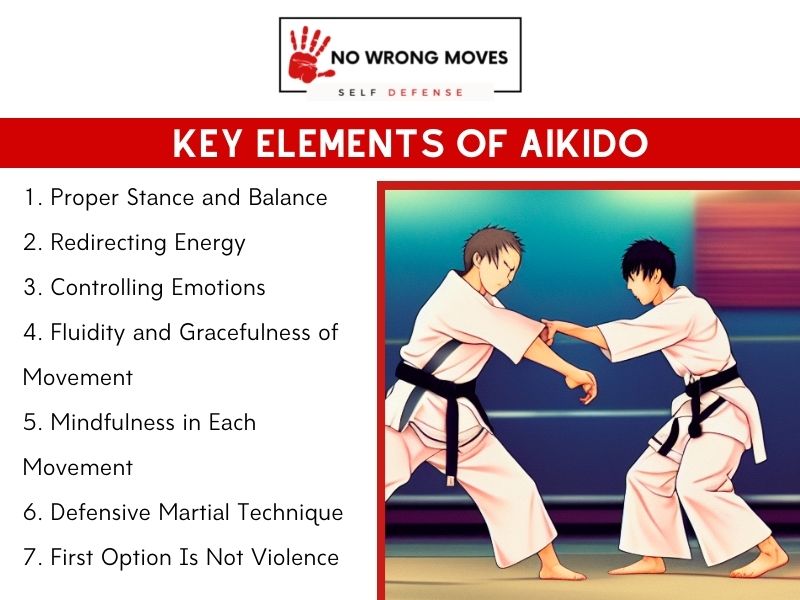
Aikido is a Japanese martial art that focuses on the proper stance and balance of the practitioner. Proper stance and balance are critical components of Aikido, as they provide the foundation for all other techniques.
A stable and balanced stance allows the practitioner to move fluidly and with control, making it easier to perform techniques effectively.
In Aikido, practitioners learn to redirect their opponent's energy rather than using force against them. Redirecting energy is one of the fundamental aspects of Aikido, and it's difficult to separate this idea from the sport itself.
Through properly redirecting an opponent's energy, Aikido practitioners can use their opponent's momentum against them, rather than relying on their own strength.
Apart from physical techniques, Aikido also emphasizes controlling one's emotions. Practitioners learn to remain calm and focused, even in stressful situations.
Aikido also places a strong emphasis on non-violent conflict resolution. The first option in any situation is to find a peaceful resolution, rather than resorting to violence.
Remember that in Aikido, the first option is not violence, and it reflects the overall philosophy of Aikido as a martial art focused on peace and harmony.
Key Elements Of Kendo
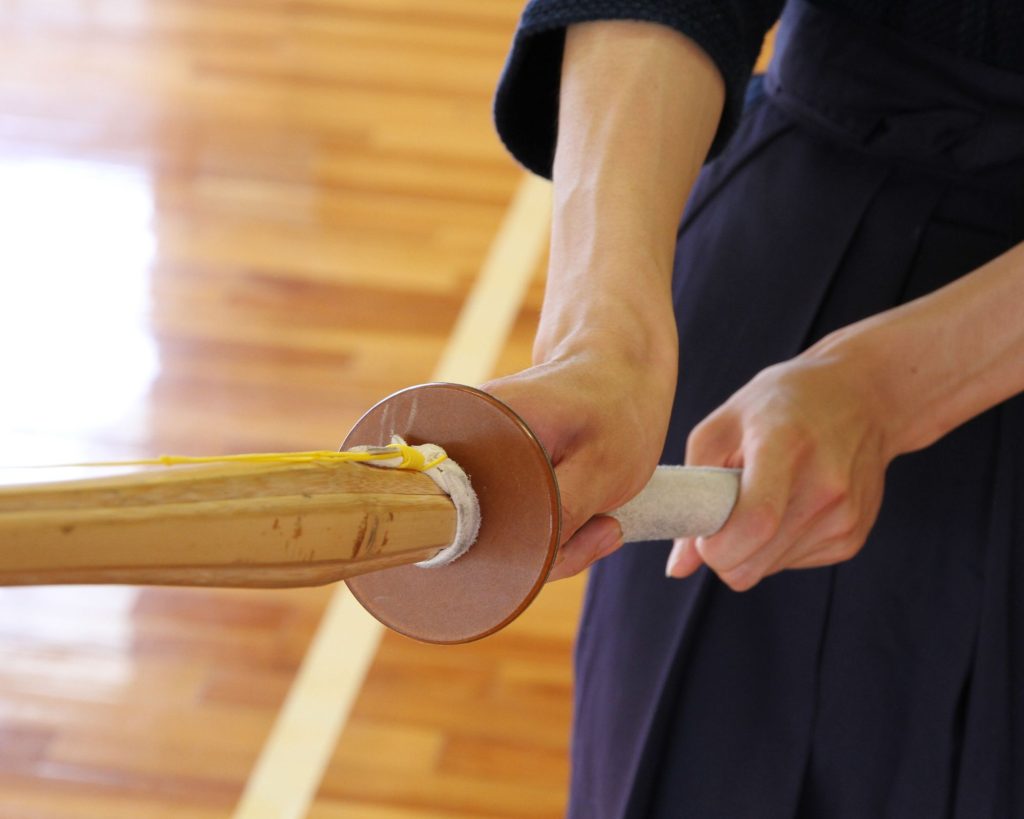
The following are key elements of Kendo that you'll need to be very mindful of during your training:
- The use of a bamboo sword, or shinai, to simulate a Japanese katana, allowing you to exert full effort during practice, all the while still maintaining a safe and controlled environment.
- The focus on proper form and etiquette in order to maintain discipline and respect for one's opponent.
- The use of consistent sparring to improve one's technique and ability.
- The emphasis on self-improvement and inner strength.
Each of these elements is important in its own way, contributing to the overall art of Kendo.
The use of a shinai instead of an actual sword, like I mentioned, promotes safety and allows for a controlled practice environment. It's a great way to make sure your beloved limbs stay firmly attached to your body while training.
Meanwhile, its focus on proper form and etiquette helps to maintain discipline and respect among practitioners.
The use of sparring allows students to test their skills against others and improve their techniques, and the emphasis on self-improvement encourages individuals to work hard and improve themselves both physically and mentally.
Together, these elements make Kendo a well-rounded martial art with benefits that extend beyond the physical realm.
Another thing I think is important to look at is the different rankings and levels in each art. if you are looking to take up either Aikido or Kendo, whether as a hobbyist or to compete, you need to understand the different levels of proficiency and what is required for testing and ranking.
Aikido Rankings & Levels
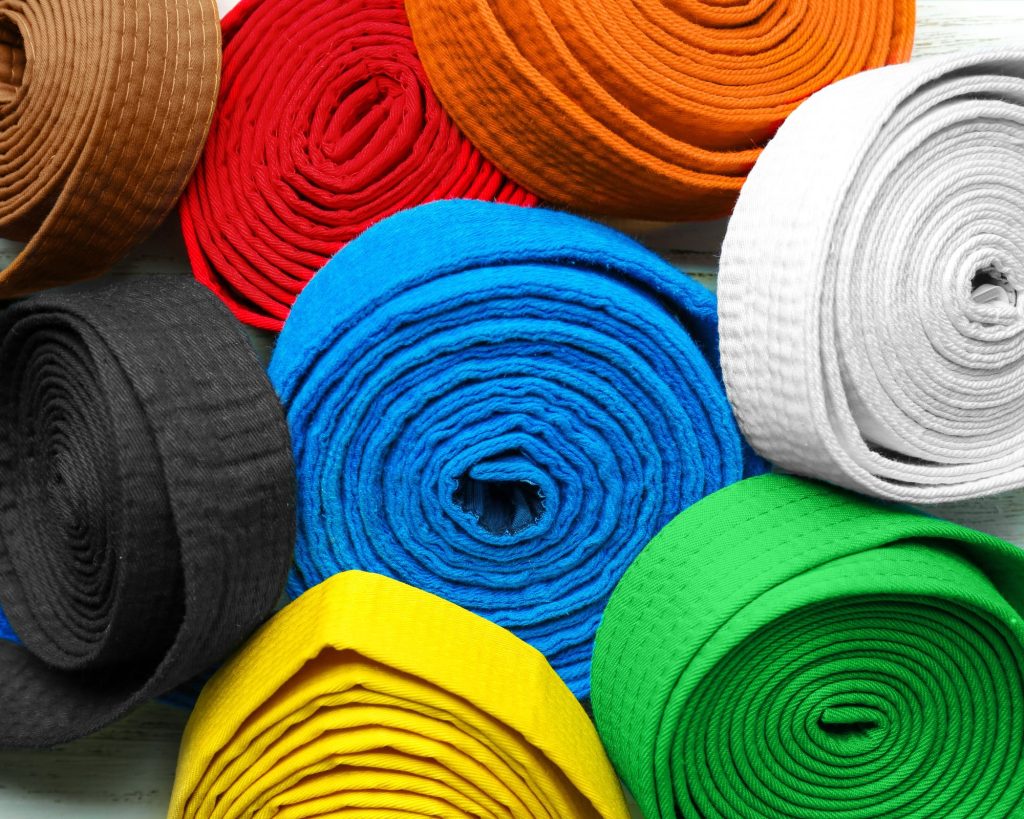
Aikido is a discipline that has many different levels, each represented by a different colored belt. The first level is white belt, which is for beginner students. Once you have mastered the basics of Aikido, you can move on to the blue belt, which is for intermediate students.
And finally, once you have mastered the art of Aikido, you can become a black belt, which is the highest level.
There are three degrees as a black belt holder: 1st dan, 2nd dan, and 3rd dan black belt. In order to achieve each of these degrees, you must pass a test that proves your mastery of Aikido.
There are also other ranks and colors that exist outside of the traditional ranking system. In some Western Aikido schools, there are more ranks added in between 1st dan and 2nd dan.
These ranks can be any combination of colors, and it allows for students to be promoted at a more gradual pace and helps to distinguish between students of different ranks.
Kendo Rankings & Levels

Technical expertise in kendo is measured by a person's rank, grade, or level. In 1883, the kyū and dan grading system was established to do just that--determine proficiency.
The dan levels range from sho-dan (初段), or first-dan, to jū-dan (十段) or tenth-dan. Below first-dan are usually six grades known as kyu, with rokkyū (六級), or sixth kyu ,being the lowest grade and ikkyū (一級), or first kyu, being the immediate grade below first-dan.
Advancing ranks isn't a vanity project, in case you were curious. Attire is the same for all kendo grades, irrespective of the rank.
Children usually hold kyu ranks in Japan, and 1st kyu (ikkyū) is their initial exam and grade. Adults, in contrast, often take shodan (1st dan) as their first exam. In countries outside Japan, kendoka usually pass through every kyu rank before being eligible for dan ranks.
The highest dan grade that can be achieved through a physical kendo skills test is the hachi-dan (八段) or eighth-dan.
The All Japan Kendo Federation, or the AJKF, doesn't award the Kendoka ninth-dan (九段) or tenth-dan (十段) anymore, but the FIK allows national kendo organizations to establish a special committee to award these grades.
Ninth-dan kendōka is still active in Japanese Kendo. Following the establishment of the AJKF in 1952, only five Kendōka were ever awarded the rank of 10th-dan.
These five Kendōka--Ogawa Kinnosuke, Moriji Mochida, Nakano Sousuke, Saimura Gorou, and Ooasa Yuuji--were awarded the 10th-dan almost all in 1957, in the same year. Unfortunately, all of them are now also deceased.
Like I mentioned a bit ago, there aren't any visible differences in dress between kendo grades. Those in the lower dan levels may dress the same as those in the upper dan levels.
Aikido Vs. Kendo Attire
This section simply compares the clothing and uniforms that practitioners wear in combat.
Aikido Attire:
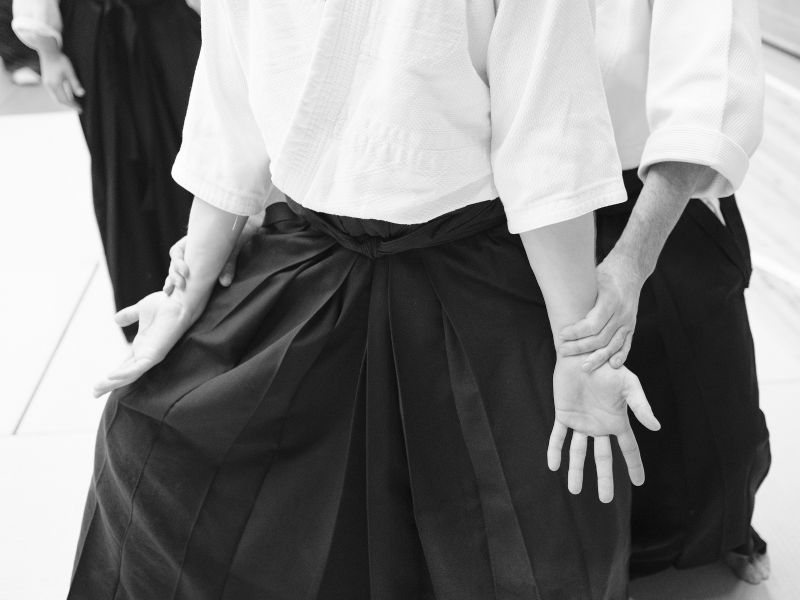
Most aikido practitioners wear a white dogi, or “uniform.” The dogi is a loose-fitting cotton kimono with a belt. In some schools, aikido students also wear hakama, which are pleated trousers that are tied at the waist and fall below the knee.
Male practitioners often don white tabi (socks), while female practitioners often wear white zori (wooden sandals). Some people also choose to practice without any clothes on in order to better feel their body and movements, but this isn't all too common.
Kendo Attire:

Kendo practitioners wear protective armor called "bōgu." The bōgu consists of a helmet called a "men," chest protector called a "dō," hand protectors called a "kote," and waist and groin protector called a "tare."
When properly worn, the bōgu protects the practitioner from strikes to vital areas and allows for safe full-power strikes during both practice and competition.
What A Typical Aikido Training Session Looks Like
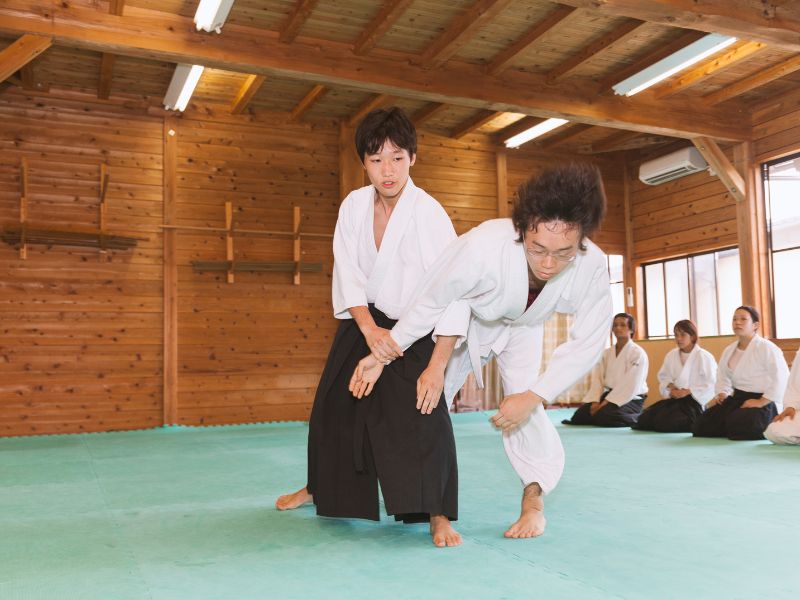
A typical Aikido practice session usually starts with a bow. This is a sign of respect for the dojo, the other students, and the instructor. The etiquette of aikido extends beyond just the bow, though. One must always be respectful, appreciative, and protective of all beings.
This attitude must be carried throughout the entire practice session.
Physical strain, whether during conditioning or in sparring against others, is part and parcel of Aikido. As such, practitioners need to maintain good manners and a positive attitude whenever they're in aikido class.
Aikido teaches you how to handle violence, but it still ultimately strives for peace, so never let your ego get in the way during your training.
Also remember that non-resistance is an essential element of proper aikido technique execution. Intercepting, deflecting, and redirecting an attack utilize the momentum and inertia of the attack.
Note that non-resistance does not mean being passively overpowered by the attack. But if you can avoid physical conflict, then you absolutely should.
It is also always important to maintain good posture and a relaxed body. Good posture includes maintaining your balance and keeping your center of gravity low. This helps you to be more aware of your surroundings and to respond more effectively to any situation.
Maintaining a relaxed body allows you to move more freely and makes it less likely that you will be thrown off balance by an attacker.
Similarly, be sure to focus on your breathing during aikido practice. This helps to calm and focus the mind, allowing for better decision making and execution of techniques.
Next, warm-up exercises are often done, including stretches and rolling or breakfalls (ukemi). These help to prepare the body for physical activity and prevent injury.
Following warm-ups, the instructor will lead the class through various aikido techniques and movements. These often involve practicing with a partner, called uke-nage (uke being the attacker, nage being the defender).
Practice with a spirit of cooperation, not necessarily competition. The goal is to mutually improve each other's technique and understanding of aikido principles, not to overpower or dominate the other person.
The practice session may also include weapons training, using a wooden sword (bokken) and wooden staff (jo). Weapons techniques often involve similar principles to those practiced with empty-handed techniques, but provide another layer of complexity and challenge.
What A Typical Kendo Training Session Looks Like

You can expect a class to go about in this fashion:
- Warm-Ups
- Suburi
- Kata
- Randori
- Cool-Downs and Clean-Ups
When you arrive at a Kendo practice class, the first thing you will do is warm up. This usually involves some light stretching and calisthenics to get your body ready for the physical activity to come. After the warm-up, you will put on your armor.
After everyone is suited up in their armor, the next thing you will do is suburi. Suburi are basic swings of the shinai, or bamboo sword, to warm up your arms and get a feel for the weapon.
You will start with slow, controlled swings and then gradually increase the speed and power as you get more comfortable.
After the suburi, you will move on to kata. Kata are pre-arranged sequences of moves that simulate a fight between two opponents.
There are many different kata, each with its own name and purpose. Some kata are designed to teach specific techniques, while others are simply for exercise or to instill principles of movement and footwork.
Once everyone has had a chance to practice their kata, it will be time for randori. Randori is free sparring between two opponents. The goal isn't to score points or land hits, but simply to practice your techniques in a realistic setting.
At first, you will likely be paired up with someone of similar size and skill level so that things are fair. Naturally, as you improve, you will be matched up with more challenging opponents.
Once your randori is done, it's time to cool down and clean up. This usually involves some more stretching and calisthenics to help your body recover from all that physical exertion.
If the last few sections have been a bit full-on or a bit too technical, you will like this next section! Why? Because who doesn't love a good martial arts flick?
Both Aikido and Kendo have been featured in a number of films and TV shows, so if you want to learn more about them, then entertain yourself with the following 👊
Aikido Movies

These are some of the top movies and shows with Aikido in them:
- The Blind Swordsman: Zatoichi (2003)
- The Last Samurai (2003)
- Kill Bill: Vol. 1 (2003) and Kill Bill: Vol. 2 (2004)
- Street Fighter (1994)
- Ong-Bak: The Thai Warrior (2003)
- The Challenge (1982) TV series
Aikido can also be seen in popular shows such as:
- Daredevil (2015) TV series
- Arrow (2012) TV series
- Alias (2001-2006) TV series
- Chuck (2007-2012) TV series
- Xena: Warrior Princess (1995-2001) TV series
Next up, some good movies with Kendo in them are:
- The Last Samurai (2003)
- Kendo: A Way of the Sword (2014)
- The Blind Swordsman: Zatoichi (2003)
- Princess Mononoke (1997)
And as a final added treat, it's actually also common to see Kendo portrayed in television shows and anime, such as Rurouni Kenshin and Bleach.
Conclusion: Aikido Vs. Kendo
I hope you now have a deeper understanding of Aikido and Kendo. In all truth, it is not about which discipline is "better" as they each have their pros and cons.
If you do plan on starting classes for either, please check out my other related posts, as I have tried my best to answer all the FAQs related to the art.
Feel free to share this post and any graphics you like, and of course, if you have any questions or thoughts, drop them below or shoot me an email, and I will be happy to assist 🙂
If you're curious to learn more about Kendo, click Is Kendo Dangerous? Dangers, Risks & Injuries EXPLAINED! - No Wrong Moves Martial Arts!
[author-box-jpx-fitness]
